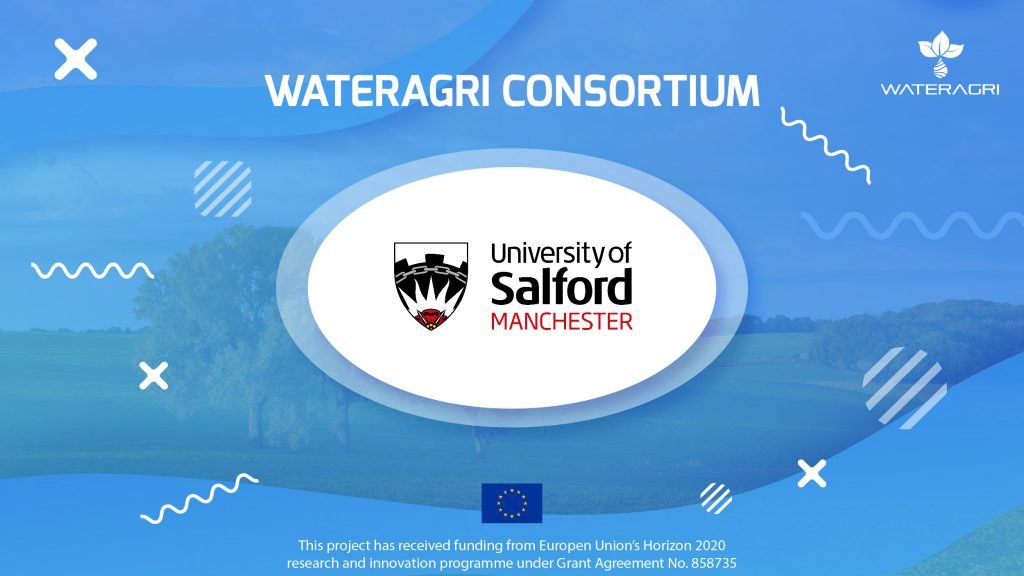The University of Salford, Manchester, is a public research university in Salford, Greater Manchester. The Royal Technical Institute, Salford, which opened in 1896, became a College of Advanced Technology in 1956 and gained university status, following the Robbins Report into higher education, in 1967. We have 20,000 students.
The school has active researchers in physical and computer modelling for engineering and environmental solutions addressing critical challenges that our human society is facing today. Its internationally recognized academics have novel contributions to the fundamental knowledge and technology development in the water environment, hydrology, soil physics, water and environment contamination, and natural resource management. All these match the requirements of WATERAGRI.
USAL will focus on the farm-scale hydrology modelling in WATERAGRI. Salford has developed a novel physicochemical water-vapor sorption isotherm and water retention characteristic (WVSI-WRC) model of unsaturated soils. Different from conventional models used in unsaturated subsurface hydrology, all of them are purely empirical, the new model, which has been praised as a big advance in the topic, is established on the underlying physics of pore surface adsorption and capillary condensation. For this reason, all parameters in the model have their physical meaning, which is decided by the interfacial physicochemical mechanisms involved.
In collaboration with ULUND and Assessment Technologies Water (UK) Ltd, USAL will demonstrate the new USAL developed Dewaterability Estimation Test (DET) device, which measures the dewaterability of sludges both very accurately, and also more than twice as quickly as the Capillary Suction Time (CST) test technology that has been in use since the 1970s.

Key persons
Prof. Miklas Scholz (male) holds a 20% full-time equivalent position at USAL. He will be responsible for USAL’s contribution to the further development of the DET device and its demonstration in several case studies. He is the main inventor of the DET device. Prof. Scholz also contributes to ULUND’s research as the principle investigator of WATERAGRI (see ULUND’s partner profile).
Dr Yu (Wayne) Wang (male) has a long-standing research background in civil and environmental engineering. He has led and participated in a number of multidisciplinary projects in broad areas of subsurface hydrology, unsaturated soil physics, soil erosion, soil contamination, slope stability, flood prediction, concrete durability, composite manufacturing and machining, thermal phase change and multiphase flow. Wayne has developed extensive knowledge and skills in the mathematical modelling and numerical simulation of mass transfer in porous media and the fluid-structure interactions at microscopic pore scale and macroscopic material scale. He made novel contributions to the fundamental science and technology development:
‒ Development of a novel analytical physicochemical model for water retention characteristics of porous materials, which had a high impact in hydrology, geotechnics and soil physics areas.
‒ Creation of a comprehensive model for ionic transport in porous materials, which has been successfully applied and widely cited in the application of concrete durability in saline environments.
‒ Formulation of a novel dual porosity modelling technology for fluid flow in complex porous materials, which has been successfully applied and highly cited in the application of liquid composite moulding process analysis and the prediction of moisture infiltration in woven fabric composites.
Dr Blake Prime (male) leads the commercialisation work for the USAL team. He works for the research and innovation division and supports spin-off companies as the intellectual property manager. Dr Prime is responsible for the identification, management and exploitation of intellectual property across the university. He supports circa 30 active projects and 5 to 10 patents at any given time. Blake has budgetary responsibility for £150k per annum to solicit, protect and develop intellectual assets. He defines the scale of commercial opportunity through primary and secondary market research as well as identifies and engages with appropriate prospective licensees or funders. As a result, he negotiated and delivered multiple commercialisation deals in a range of technology sectors including Optimum Imaging Ltd, SALSA Sound Ltd, ‘Spray’ Aerosol valve technology and Klip-2-lift. He also supported the development of the DET device including patent application and spin-off company formation.
Prof. Apostolos Antonacopoulos (male) leads the Pattern Recognition and Image Analysis research lab at USAL. He has worked and published extensively on various problems in Document Analysis and Understanding (Image Enhancement, Segmentation, Recognition, Performance Evaluation) as well as on other applications of Pattern Recognition and Image Analysis. He is an Associate Editor of Cultural Heritage Digitisation. He is currently the President of the International Association for Pattern Recognition (IAPR), having also previously held the posts of Treasurer, 1st and 2nd Vice President. He has also chaired or served as a member of a number of IAPR and other professional committees. He has significant experience in leading and participating in national, European (FP7 and earlier) and industry-sponsored projects. Recent significant project involvement includes the €4M European Newspapers EU-funded project (extraction and recognition of text in newspapers for the European Digital Library), the €1.8 SUCCEED EU-funded support action for the Centre of Competence in Digitisation and the US$ 734,000 Early Modern OCR project (EMOP) funded by the Andrew W. Mellon Foundation. He is one of the inventors of the DET device.
Dr Christian Clausner (male) is a post-doctoral fellow working in the Pattern Recognition and Image Analysis research lab. His research expertise is in pattern recognition and image analysis. He will work on the DET device.